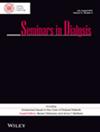终末期肾病血液透析患者血管通路血栓的发生率。
IF 1
4区 医学
Q3 UROLOGY & NEPHROLOGY
引用次数: 0
摘要
血管通路血栓形成(VAT)在接受血液透析的患者中很常见,并导致错过透析治疗、住院、导管放置和移植物/瘘管放弃。本文综述了高凝性和VAT之间的关系以及终末期肾脏疾病(ESKD)高凝状态的高患病率。本文综述了抗血栓和抗凝药物在预防VAT中的作用。文章最后回顾了在ESKD患者中使用维生素K拮抗剂的独特挑战。本文章由计算机程序翻译,如有差异,请以英文原文为准。
Frequent vascular access thrombosis in a patient with end stage kidney disease on hemodialysis.
Vascular access thrombosis (VAT) is common among patients receiving hemodialysis and leads to missed dialysis treatments, hospitalizations, catheter placement, and graft/fistula abandonment. This article reviews the association between hypercoagulability and VAT and the high prevalence of hypercoagulable states in end-stage kidney disease (ESKD). This article reviews the role of antithrombotic and anticoagulant medications in preventing VAT. The article concludes by reviewing the unique challenges of using vitamin K antagonists in patients with ESKD.
求助全文
通过发布文献求助,成功后即可免费获取论文全文。
去求助
来源期刊

Seminars in Dialysis
医学-泌尿学与肾脏学
CiteScore
3.00
自引率
6.20%
发文量
91
审稿时长
4-8 weeks
期刊介绍:
Seminars in Dialysis is a bimonthly publication focusing exclusively on cutting-edge clinical aspects of dialysis therapy. Besides publishing papers by the most respected names in the field of dialysis, the Journal has unique useful features, all designed to keep you current:
-Fellows Forum
-Dialysis rounds
-Editorials
-Opinions
-Briefly noted
-Summary and Comment
-Guest Edited Issues
-Special Articles
Virtually everything you read in Seminars in Dialysis is written or solicited by the editors after choosing the most effective of nine different editorial styles and formats. They know that facts, speculations, ''how-to-do-it'' information, opinions, and news reports all play important roles in your education and the patient care you provide.
Alternate issues of the journal are guest edited and focus on a single clinical topic in dialysis.
 求助内容:
求助内容: 应助结果提醒方式:
应助结果提醒方式:


